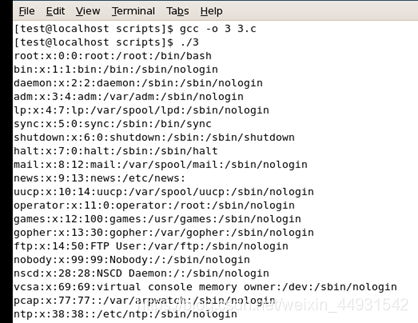文件操作实验
实验目标:
- 掌握Linux文件操作函数的使用
实验环境与工作条件:
Red Head Linux5.0以上操作系统
实验内容:
- 设计一个程序,要求打开文件“pass”,如果没有这个文件,新建此文件,权限设置为只有所有者有只读权限。
#include<unistd.h>
#include<stdlib.h>
#include<stdio.h>
#include<sys/types.h>
#include<sys/stat.h>
#include<fcntl.h>
int main()
{
int fd;
if((fd=open("pass",O_CREAT))<0)
{
printf("not exist\n");
}
printf("create file pass,it is:%d\n",fd);
chmod("pass",S_IRUSR|S_IWUSR);
return 0;
}

- 设计一个程序,要求新建一个文件“hello”,利用write函数将“Linux下c软件设计”字符串写入该文件(如果用fwrite函数写入,应该怎么实现)。
#include <stdio.h>
#include <unistd.h>
#include <stdlib.h>
#include <sys/types.h>
#include <sys/stat.h>
#include <fcntl.h>
#include <string.h>
int main()
{
int fd,twrite;
if((fd=open("./hello",O_CREAT|O_TRUNC|O_WRONLY,0777))<0)
{
printf("open file error");
exit(1);
}
char str[]="the design of C software under Linux";
if((twrite=write(fd,str,sizeof(str)))<0)
{
printf("write file error");
exit(1);
}
close(fd);
return 0;
}

- 设计一个程序,要求利用read函数读取系统文件“/etc/passwd”,并在终端中显示输出。
#include <stdio.h>
#include <sys/types.h>
#include <sys/stat.h>
#include <fcntl.h>
#include <unistd.h>
#include <stdlib.h>
int main()
{
int fd,rtype,wtype;
char str[30];
if((fd=open("/etc/passwd",O_RDONLY))<0)
{
printf("read file error!");
exit(1);
}
while((rtype=read(fd,str,30))>0)
{
if((wtype=write(STDOUT_FILENO,str,rtype))<0)
printf("write file error");
}
close(fd);
return 0;
}


4. 设计一个程序,要求打开文件“pass”,如果没有这个文件,新建此文件;读取系统文件“/etc/passwd”,把文件中的内容都写入“pass”文件。
#include <stdio.h>
#include <sys/types.h>
#include <sys/stat.h>
#include <fcntl.h>
#include <unistd.h>
#include <stdlib.h>
int main()
{
int fdsrc,fddes,nbytes,wtype;
char str[30];
if((fddes=open("pass",O_CREAT|O_TRUNC|O_WRONLY,0600))<0)
{
printf("open file pass error");
exit(1);
}
if((fdsrc=open("/etc/passwd",O_RDONLY))<0)
{
printf("open file error");
exit(1);
}
while((nbytes=read(fdsrc,str,30))>0)
{
if((wtype=write(fddes,str,30))<0)
printf("write file error");
}
close(fdsrc);
close(fddes);
}



5. 设计一个程序,要求将10分别以十进制、八进制和十六进制输出(这里我采用了sprintf函数)。
#include <stdio.h>
#include <stdlib.h>
#include <sys/types.h>
#include <sys/stat.h>
#include <fcntl.h>
#include<string.h>
int main()
{
int x=10;
char FX[20],PX[20],HX[20];
sprintf(FX,"%x",x);
sprintf(PX,"%o",x);
sprintf(HX,"%d",x);
write(1,PX,strlen(PX));
printf("\n");
write(1,FX,strlen(FX));
printf("\n");
write(1,HX,strlen(HX));
printf("\n");
return 0;
}

6. 设计一个程序,要求新建一个目录,预设权限为 dr–r--r–。
#include <stdio.h>
#include <unistd.h>
#include <stdlib.h>
#include <sys/types.h>
#include <sys/stat.h>
int main()
{
system("mkdir exercise");
chmod("exercise",0444);
return 0;
}

7. 设计一个程序,要求用命令ls -l > list 建立一个文件,然后建立一个软链接“ls1”和一个硬链接为“ls2”,并查看两个链接文件和list文件。
#include<unistd.h>
#include<stdlib.h>
int main()
{
system("ls -l > list");//>输出重定向,将当前目录下的内容输入到list中
symlink("list","l1");
link("list","l2");
system("ls list -l");
system("ls l1 -l");
system("ls l2 -l");
return 0;
}

